The Indian Ocean Dipole (IOD) is a climate phenomenon in the Indian Ocean. The Indian Ocean dipole is the difference in sea surface temperatures (SSTs) between the Eastern and Western regions of the Indian Ocean. The IOD can significantly impact weather patterns and climate in the surrounding areas, including parts of Africa, Southeast Asia, and Australia. As a result, the Indian Ocean Dipole climate index is closely watched by long-range forecasters because of this phenomenon’s impact on subseasonal and seasonal timescales.
Introduction to the Indian Ocean Dipole
The Indian Ocean Dipole can be considered the Indian Ocean basin branch of the Walker Cell, which, in turn, is associated with the El Niño Southern Oscillation. The IOD is defined by the Dipole Mode Index (DMI), which is a measure of the anomalous sea surface temperature (SST) gradient between the western equatorial Indian Ocean (50E-70E and 10S-10N) and the southeastern equatorial Indian Ocean (90E-110E and 10S-0N). Changes in ocean temperatures in the west Indian Ocean and eastern Indian Ocean (i.e., the dipole) drive convection and alter the Walker Cell circulation.
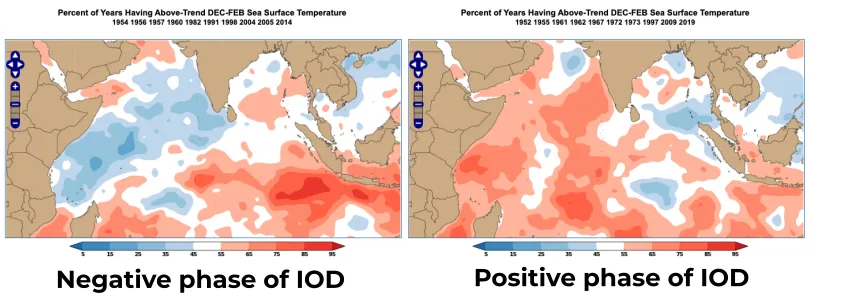
The Indian Ocean Dipole generally moves in sympathy with the phase of the El Niño Southern Oscillation (ENSO) and the Southern Oscillation Index (SOI), but there are occasions when it doesn’t behave quite as expected. It can really come into its own during a neutral ENSO, such as the strong positive event in 2019. Another difference is that ENSO normally peaks in the Northern Hemisphere winter, while the IOD can peak anytime.
The impacts of IOD are felt in the tropics and weather patterns across much of the mid-latitudes. Like the El Niño and La Niña, the Indian Ocean dipole impacts the preferred regions of ascending and descending air in the Indian tropical ocean. The phase of the IOD contributes to determining important aspects of local and global climates.
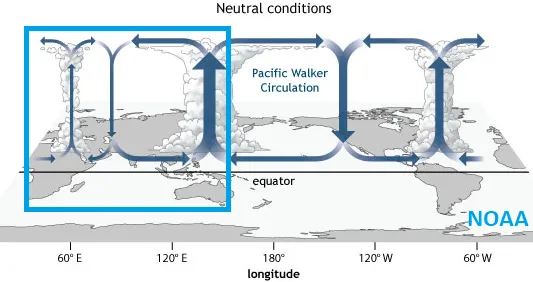
Negative Phase of the IOD
The negative phase of the IOD is driven by cooler-than-normal SSTs off the coast of Africa and warmer-than-normal SSTs to the west of Indonesia. This configuration of surface sea temperatures boosts normal circulation.
The more robust circulation brings more consistent westerly winds over the ocean, more vigorous convection over Indonesia, and often drought conditions for the Horn of Africa. This pattern is consistent with La Niña (negative phase of ENSO).
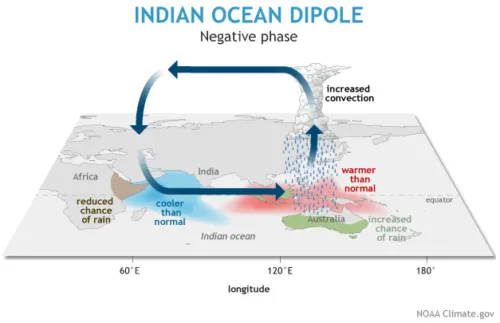

The World Climate Service has developed a powerful data mining system that enables users to quickly explore the impact of the Indian Ocean Dipole and many other indices by phase for each month of the year. This shows impacts on all the major weather variables worldwide. The maps featured in this article can be produced with just a few clicks of the mouse.
IOD Negative Phase: Impacts during US Winter
During the negative phase of the IOD in the wintertime, warmer-than-normal temperatures are more likely in the lower 48 states, especially over the Midwest (Figure 3). During a strongly negative IOD event, warm anomalies are even more likely and more widespread.
While this pattern is primarily consistent with a negative ENSO (La Niña) event, it is worth noting that during a negative phase IOD event, much of the Central US sees the opposite anomaly to that generally seen during La Niña.
During a negative phase of IOD in winter, much of the South and West are likely to be wetter than normal, with dry weather more likely in the Midwest (Figure 4).
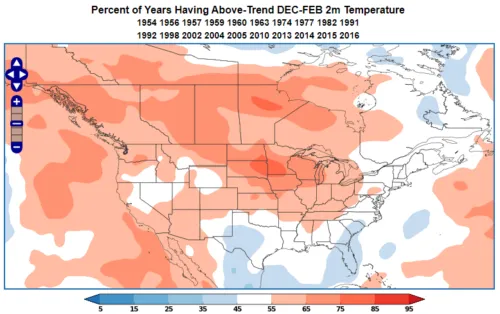
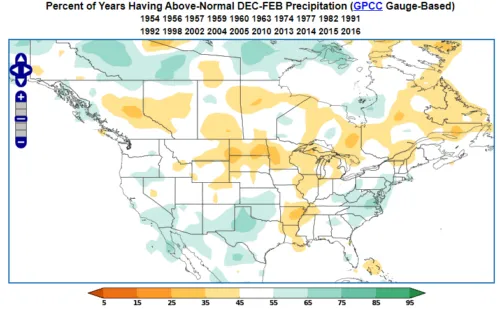
IOD Negative Phase: Impacts during US Summer
During the negative phase of the IOD in summer, there are few significant impacts, as indicated by the maps below showing a mixture of above- and below-normal probabilities. Interestingly, the Mid-Atlantic is usually cooler and wetter than normal, and Texas is typically warmer and drier than normal.
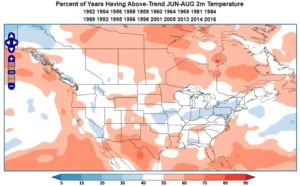
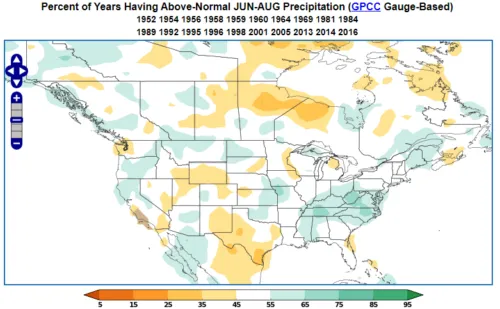
IOD Positive Phase: Events
The positive phase of the IOD is driven by warmer-than-normal SSTs off the coast of Africa and cooler-than-normal SSTs to the west of Indonesia. This configuration of surface sea temperatures reverses normal circulation, with easterly winds setting up across the equatorial Pacific.
The reversed circulation suppresses convection over Indonesia, leading to predominantly dry weather and the potential for drought. Over the Horn of Africa, convection is enhanced, and rainfall is much more abundant than usual. This pattern is consistent with El Niño (the positive phase of ENSO).
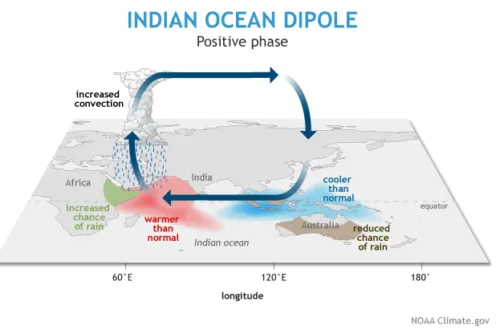
IOD Positive Phase: Impacts during the Australian Winter
During the positive phase of the IOD in the wintertime over Australia, Western Australia is usually warmer than normal, while the rest of Australia is cooler than normal (Figure 8).
During a positive phase IOD in winter, much of Australia experiences dry weather, resulting in drier-than-normal conditions. The risks of drought significantly increase (Figure 9) during positive Indian Ocean dipole events.
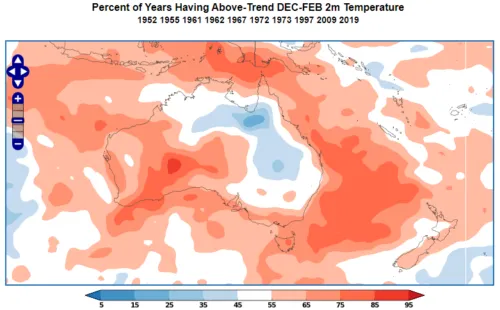
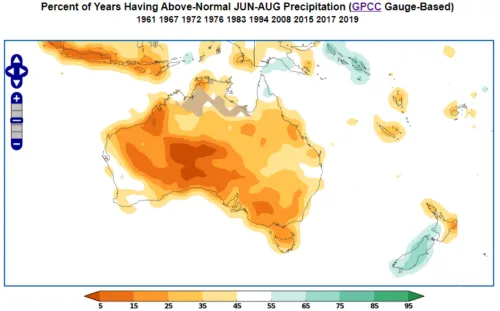
IOD Positive Phase: Impacts during the Australian Summer
In summertime, when the IOD is positive, much of Australia is warmer than normal, but the north and east interior is usually cooler than normal (Figure 10).
Western Australia is usually drier than normal during a positive IOD in summer. For the rest of the country, above-normal rainfall brings a heightened risk of flooding (Figure 11).
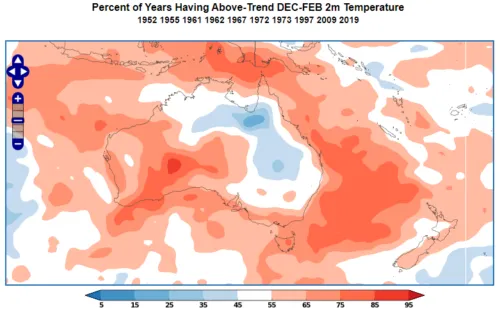
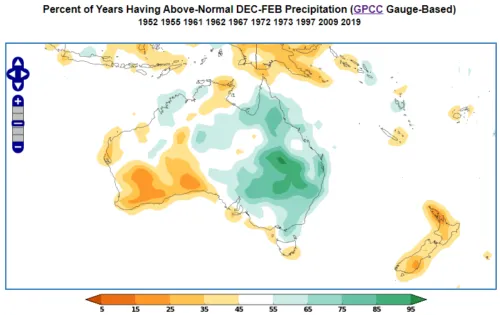
The World Climate Service provides a powerful data analysis system that enables users to quickly explore the Indian Ocean Dipole and many other indices by phase for each month of the year. This shows impacts on all the major weather parameters around the globe.
The Indian Ocean Dipole and Long-Range Forecasting
The Indian Ocean Dipole typically remains in a given phase for a few weeks to many months. Thus, the IOD is very much a seasonal climate index (as opposed to a more short-lived subseasonal climate index such as the PNA). The IOD is generally well predicted by dynamical modeling, and thus, we can usually be fairly confident about which phase it will favor in the coming months.
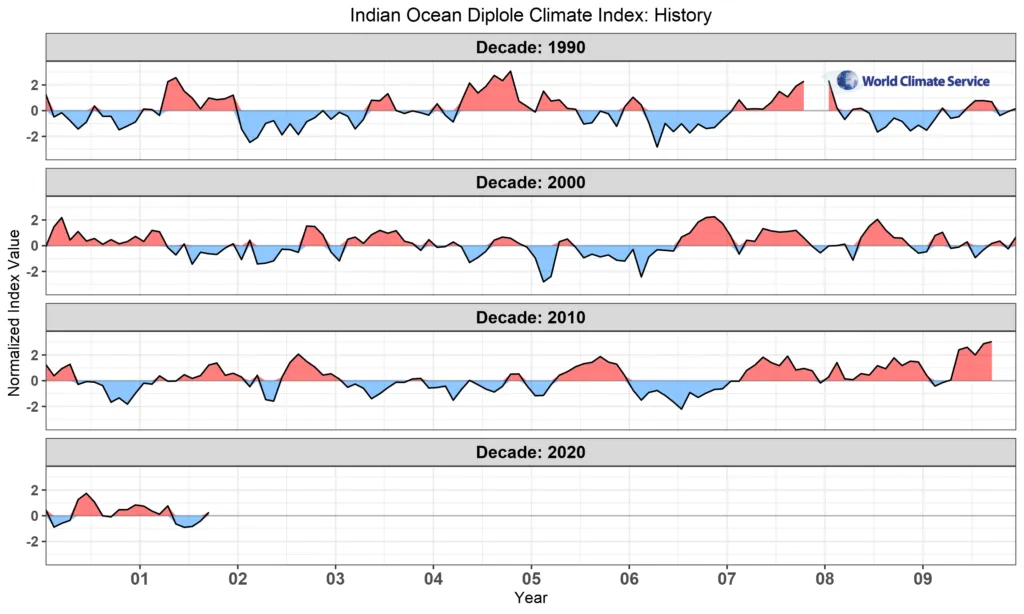
Current Status: Transition to Positive IOD Phase
As of mid-February 2023, the Indian Ocean Dipole climate index reached as high as 0.84 in mid-January 2023 but oscillated around zero. The IOD was negative during much of 2022, as shown below in Figure 14.
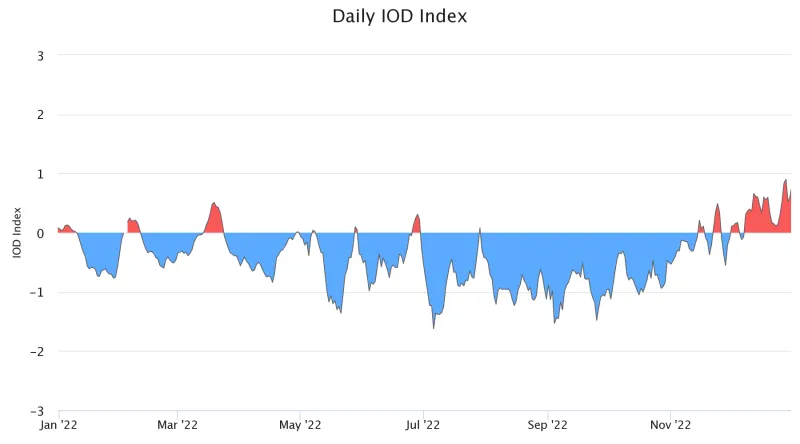
Indian Ocean Dipole Forecast: February 2023
The suite of Copernicus seasonal climate forecast models the World Climate Service post-processes to create value-added forecasts of climate indices indicates the Indian Ocean Dipole is forecast to slowly become positive during the first half of 2023, as shown in Figure 14. The cells in Fig. 15 with bold borders indicate the model shows statistically significant forecast skill for that particular month and lead time.
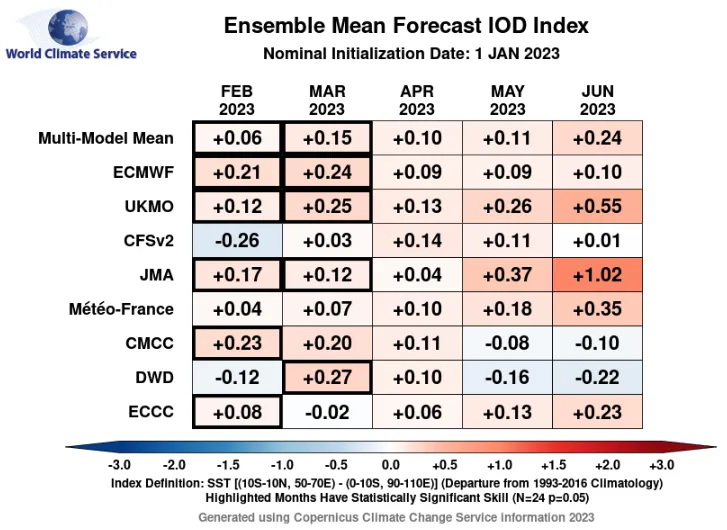

Conclusion: The Vital Role of IOD in Seasonal Forecasting
The Indian Ocean Dipole is defined by the sea surface temperatures within the Indian Ocean and can be considered the Indian Ocean branch of the Walker Cell.
Phases of the Indian Ocean Dipole often persist for many months and are generally well predicted by dynamical modeling. Therefore, the Indian Ocean Dipole is a vitally important consideration in seasonal forecasting over both the tropics and the mid-latitudes.